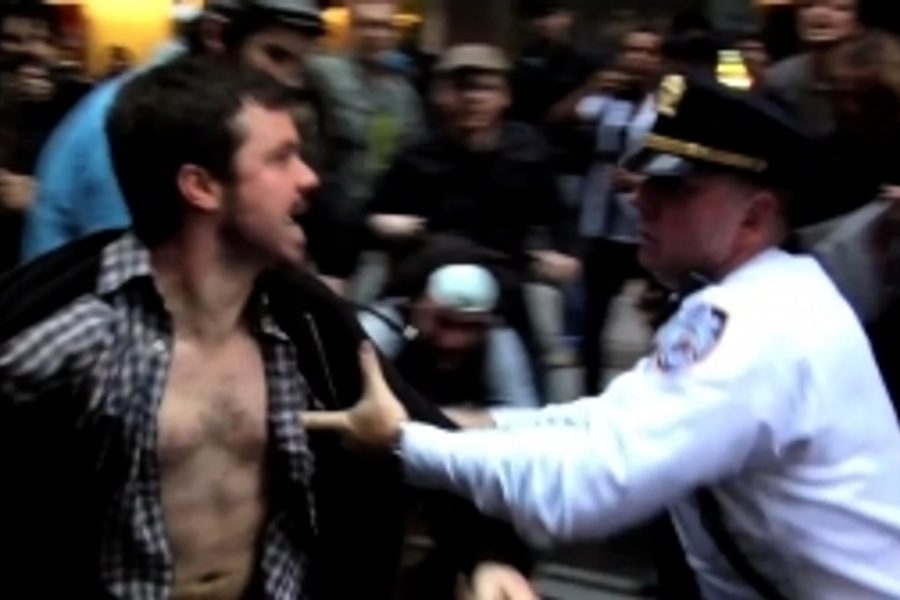
Occupy Wall Street has always been as much a media phenomenon as a political one. The revolution hasn’t exactly been televised, but Occupy’s biggest victory so far has been its radical public-relations coup, saturating both mainstream and alternative outlets with icons and images of popular protest that have been subsequently broadcast, live-streamed, and projected, bat signal-style, onto the concrete face of the New York skyline. But there are still aspects of the movement waiting to be documented.
Now that the media establishment’s spotlight has faded somewhat, a film festival devoted to Occupy at Manhattan’s Anthology Film Archives has returned those radical aesthetics to the foreground, conscious of the singular ability of old-fashioned film to capture the crackling energy of a social movement. And the films selected by the festival coordinators, Arun Gupta of the Indypendent and New York University media professor Michelle Fawcett, were presented as both a nostalgic retrospective and hopeful prequel to the next chapter.
Meshing the movement’s DIY digital production techniques with old-fashioned agit-prop sensibilities, Occupy the Film Festival parades the scenes from Occupy that have now crystallized in public memory: marching on the Brooklyn Bridge, sharing food and twiddling spirit fingers, faces young and old cheering, chanting, and contorting in clouds of pepper spray.
One of the two feature-length headliners of the festival, American Autumn, is a global overview of the political, economic, social and environmental catastrophes that spurred activists to revolt last September.
The documentary covers a sprawling range of issues, from climate change to dirty money in politics. But it’s smartly framed around the key points of the Occupy Wall Street declaration, which sets up themes for each segment outlining the issues and activists’ responses, which range from clashing with riot police to growing communal gardens.
The narrative threads together with commentary by the co-producer and writer Dennis Trainor, who also appears in some of the scenes as a fellow agitator. But the film – distributed for free on the web – mostly spotlights his diverse co-occupiers: the labor organizers, student debt resistors, environmentalists and other self-styled stars of a proudly leaderless movement.
We’re Not Broke, directed by Karin Hayes and Victoria Bruce, exposes the pro-corporate policies that drove the country toward its current massive imbalance of wealth and economic opportunity. Around the world, in fact, people are just now discovering the connection between the failure of representative democracy and plutocratic power grabs.
Other films explore the international dimensions of Occupy and related movements.
Fair Square: Occupy Amsterdam tracks the protesters who led the Amsterdam encampment that lasted for several weeks last fall, depicting the universality of the struggle to reclaim public space.
Casseroles – Montréal, 24 mai 2012 by Jérémie Battaglia applies stunning monochrome cinematography to give the rollicking parade of pot-banging protesters in Montreal in May the aesthetics of a French art film. There were also shorts that highlight the transnational intersections of different youth-led insurgencies of the past year, aligning Occupy with the Greek anti-austerity protests, the Arab Spring uprisings (particularly the disturbing similarities in the state’s crackdowns on protesters).
There’s even a short on the collaboration and tensions within Occupy Movement Kauai, which has rubbed up against a longstanding indigenous Hawaiian anti-colonial movement.
The Revolution will be Televised rolls out a 15-minute mash-up of cherished OWS moments in San Francisco, Oakland and New York City. It’s sometimes difficult to tell in which city the protest is happening – an indicator of the versatility of the Occupy brand, as well as a portent, perhaps, of a subcultural peculiarity that raises challenges about broadening the movement’s reach.
The shorts present a spectrum of narrative angles on Occupy.
Occupy Economics comments on how Occupy’s underlying anti-capitalist analysis poses a refreshing challenge to an academic field that has often internalized and validated neoliberal ideology.
Citizen Journalist Super Suit instructs viewers on how to police-proof their guerilla video gear.
Default tells the wrenching stories of young people crippled by student loan debt peonage.
And the comedic performances of the Tax Dodgers shows how activist theater compels people to think critically without taking themselves too seriously.
Wherever Occupy is headed in its second year, the films featured at the festival have captured both the medium and the message – a testament to the vitality of storytelling as a political tool, and panorama of a movement that is helping level social inequities with each new space it claims. And this is just the first take.
Cross-posted from the Progressive.
Michelle Chen is a contributing writer at In These Times and The Nation, a contributing editor at Dissent and a co-producer of the “Belabored” podcast. She studies history at the CUNY Graduate Center. She tweets at @meeshellchen.





